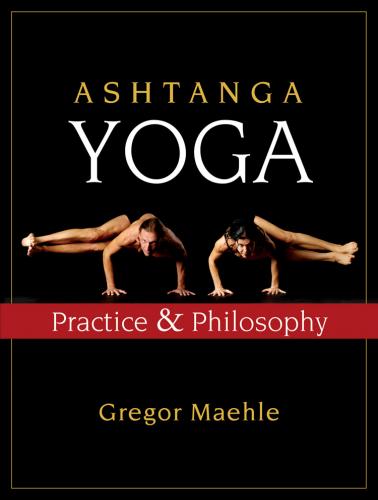Surya Namaskara A, vinyasa six (Downward Facing Dog)
The arms and legs act as strong supports so that the spine may be fully lengthened. The trunk flexors and trunk extensors are stretched, strengthened, and awakened, and carry the spine elongated.
Anyone who experiences stiffness in forward bending or who has short Achilles tendons needs a short stance in Downward Dog. If the heels are more than an inch or two off the floor, the angle of the legs to the floor does not enable the legs to be worked in such a way as to get sufficient stretch on the calves and Achilles tendons. In this case one needs to step the feet forward and shorten the stance. On the other hand, if the stance is too short the strengthening and lengthening effect on the spine and shoulders is reduced. To maximize this effect, ideally we would choose a long stance. For beginners, however, a long stance will place undue strain on the shoulders and wrists. Once the heels reach the floor, one should therefore lengthen the stance in Downward Dog. A competent teacher can assess the appropriate stance length.
FIGURE 4 INFRASPINATUS
The infraspinatus muscle outwardly rotates the humerus. “Infra” means below, “spinatus” means spine, referring to the ridge of the shoulder blade (scapula). If you touch your shoulder you will feel a transverse ridge running across itBelow this ridge is the infraspinatus musclcommonly weak and underdeveloped. Hownot everyone needs to roll the humerus outwardly: some people have it naturally outwardly rotated. This movement should onbe performed until a central or “neutral” position is achieved, which can be assessed by a qualiteacher. Overworking the infraspinatus results in unnecessary shoulder tension and pain.
Left, Surya Namaskara A, vinyasa seven (see next page)
Downward Dog is held for five breaths and, although the gaze would ideally be toward the navel, for most beginners this would lead to a collapsing of the shoulders and sacrificing the much-needed elongation of the spine. Gazing toward the feet or the knees is therefore recommended for beginners. It may take years to develop the flexibility and support strength to establish the final drishti, which is toward the navel. If a beginner starts with this gaze, it usually leads to compromising the inner integrity of this magnificent posture.
Similarly, the attempt to thrust the head down to the floor leads to a closing and hardening behind the heart, to a splaying open of the lower ribs as the abdominal muscles are released, and to a collapsing around the junction of C7 / T1. Downward Dog is like a handstand with the support of the legs and therefore needs a balance of trunk extension and trunk flexion. To go into either extreme misses the still point of balance.
Vinyasa Seven
With the end of the exhalation, the legs bend slightly, and with the inhalation the feet hop up between the hands. As the feet land they touch each other, and the torso lifts as the gaze is cast upward to the third eye (Brumadhaya Drishti). This is a repetition of the third vinyasa.
Vinyasa Eight
The exhalation folds us forward, with the fingertips eventually coming into line with the toes. This is a repetition of the second vinyasa.
Vinyasa Nine
The inhalation lifts the heart so that the back remains straight as the torso lifts, with the arms reaching out to the side.
The next exhalation returns us to Samasthiti.
Surya Namaskara B
SUN SALUTATION B
Drishti Thumbs, nose, navel
Vinyasa One
Inhaling from Samasthiti, bend the knees deeply without the heels lifting off the floor. At the same time draw your arms up above the head, working them back toward the ears and bring the palms together. The gaze lifts upward beyond the folded palms. This is Utkatasana.
Utkatasana is a good example of the principle of simultaneous expansion in opposing directions (see figure 5, page 34). The ideal here would be to squat down until the thighs are parallel to the floor; then the trunk and arms lean forward as the body regains its center of gravity. This extreme gives the optimal effect in regard to strengthening the leg and buttock muscles. The other extreme is to keep the back completely upright, without bending the legs enough. In this case we would compromise the powerful work of the legs and buttocks, which occurs only in a deep squat. The ideal is a balance between these two actions, working simultaneously in both directions.
Above, Surya Namaskara A, vinyasa eight; right, vinyasa nine
Approach the limit of your flexibility slowly when squatting down, to give the ligaments time to lengthen and strengthen. While bending the knees do not tilt the pelvis forward or backward, but allow the pelvis to maintain its neutral position and the low back its natural curve. The knees remain together. Keep the arms drawing back into the shoulder joints to keep the shoulder blades down and the neck free of excess tension. If you have a tendency to whiplash symptoms, gaze straight ahead.
From left top, Surya Namaskara B, vinyasa one (Utkatasana), vinyasa two, vinyasa three; above, vinyasa four (Chaturanga Dandasana)
Beginners are advised to raise their arms straight out in front of them, drawing them from back to front. This action avoids hyperextending the low back. The more challenging option of raising the arms out to the side may be adopted when sufficient awareness and strength have been developed.
Vinyasa Two
With the exhalation draw your palms, folded into prayer position, to touch the chest (heart center) and, folding the torso forward as you straighten your legs, place the hands down on the floor on either side of the feet.
Vinyasa Three
Inhaling, lift the chest.
Vinyasa Four
Exhaling, hop the feet back and
